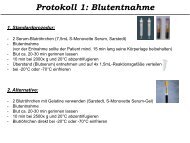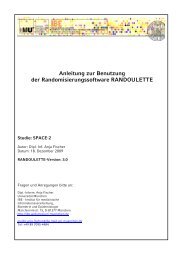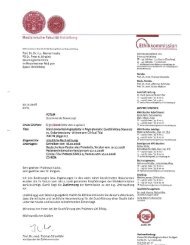CLINICAL TRIAL PROTOCOL SPACE 2 Stent ... - SPACE-2 Studie
CLINICAL TRIAL PROTOCOL SPACE 2 Stent ... - SPACE-2 Studie
CLINICAL TRIAL PROTOCOL SPACE 2 Stent ... - SPACE-2 Studie
You also want an ePaper? Increase the reach of your titles
YUMPU automatically turns print PDFs into web optimized ePapers that Google loves.
Clinical Trial Code: <strong>SPACE</strong> 2 Version: 10. October 2008 Final<br />
A pre-existing disease or symptom will not be considered an adverse event unless there<br />
will be an untoward change in its intensity, frequency or quality. This change will be<br />
documented by an investigator.<br />
Surgical procedures themselves are not AEs; they are therapeutic measures for<br />
conditions that require surgery. The condition for which the surgery is required may be<br />
an AE. Planned surgical measures permitted by the clinical trial protocol and the<br />
condition(s) leading to these measures are not AEs, if the condition leading to the<br />
measure was present prior to inclusion into the trial.<br />
AEs are classified as "non-serious" or "serious".<br />
7.1.2 Serious adverse event<br />
A serious adverse event (SAE) is one that at any dose:<br />
Results in death<br />
Is life-threatening (the term life-threatening refers to an event in which the subject was<br />
at risk of death at the time of event and not to an event which hypothetically might<br />
have cause death if it was more severe)<br />
Requires subject hospitalization or prolongation of existing hospitalization<br />
Results in persistent or significant disability/ incapacity or<br />
Is a congenital anomaly/ birth defect.<br />
7.1.3 Expectedness<br />
An ‘unexpected’ adverse event is one the nature or severity of which is not consistent<br />
with the trial procedures. Furthermore, reports which add significant information on<br />
specificity or severity of a known adverse reaction constitute ‘unexpected’ events.<br />
7.1.4 Outcome event<br />
Outcome events are the components of the endpoints (see chapter 6.3). Most of these<br />
will also be SAEs.<br />
7.2 Period of observation and documentation<br />
All AEs reported by the subject or detected by the investigator, will be collected during<br />
the trial and must be documented on the appropriate pages of the CRF. AEs must also<br />
be documented in the subject’s medical records.<br />
In this trial, all AEs that occur after the subject has signed the informed consent<br />
document will be documented on the pages provided in the CRF. All subjects who have<br />
AEs, whether considered associated with the use of the trial medication or not, must be<br />
_______________________________________________________________________________________________________<br />
Page 25 of 49





